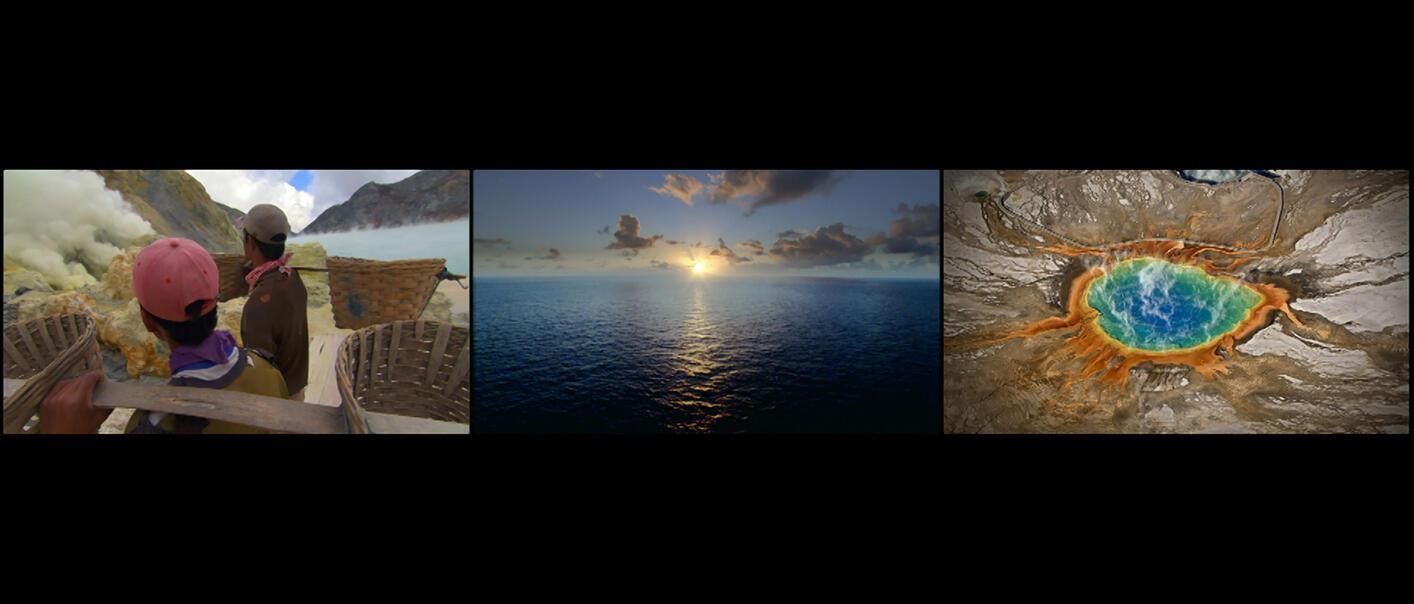

Featuring Joy Gregory, Kader Attia, and Lubna Chowdhary
The extraction of raw materials from the earth and people from their lands leaves scars that are physical, economic, and psychic.
Across fragmented geographies, the works in this first section tell stories of lives, objects and materials uprooted and displaced from their homelands.
Through weaving together transnational perspectives, the artists create works which materialise histories.
Joy Gregory's piece weaves together both sides of the sugar trade: the wealth of 18th century Devonian sugar traders and the lives of the enslaved people working in the Caribbean. Images of Devonshire country houses, ships sailing and arriving on Caribbean shores, and people working in cane fields emerge as islands in the sea of fabric.
Expanding her photographic practice, Gregory maps the oceanic blue fabric with rivers of her own hair, exposing cyanotype streams of white sea foam. Layering bodily material onto the work in these curling rivers across the tapestry accentuates the bodily experience of forced migration during the Transatlantic slave trade.
Bordering the panel are alternating images of people in metal slave restraints, designed to prohibit them from eating the sugar cane they farmed, and ornate silver sugar shakers owned by British consumers for dusting their food with sweetness. In her work, Gregory brings together the human cost of the industrial process of sugar refinement with the cultural refinement the trade offered to Devonshire's traders.
Inspired by an embroidered textile from Combesatchfield House made in the mid-1700s, The Sweetest Thing draws inspiration from the sewn Biblical scenes and depiction of a Black enslaved servant. In her work, Gregory stitches the financial compensation each estate received for the ‘loss’ of enslaved people at the abolition of slavery below the images of lavish local manor houses.
The Sweetest Thing was commissioned for the Royal Albert Memorial Museum and Art Gallery in Exeter and their 2022 exhibition ‘In Plain Sight’. This show featured work by artists responding to the often-invisible legacy of the trade in enslaved people by highlighting evidence of the trade in RAMM’s collections. Working as a physical record of a history often neglected, Gregory’s work illustrates the ancestral significance of cultural objects.
Kader Attia’s slide and video installation Dispossession presents displaced spiritual objects transported from Africa to the vaults of the Vatican by Christian missionaries. These objects, made from metal and wood, carved, and melded by hand, express African peoples' polytheistic religions and belief traditions. The objects represent and embody ritualistic and ceremonial heritages confiscated and destroyed by Christian missionaries to exact religious conversion.
Just as these objects were detached from their cultural meaning, through the work of European missionaries, African peoples were untethered from their ancestral beliefs. The artist presents the extraction of these objects from their homeland as material evidence of colonial cultural theft.
A carousel of slides flicks through photographs of masks, fetish figures, furniture, and jewellery in the Vatican’s Ethnographic collection whilst a video of four interviews between Attia, an anthropologist, an art historian, a priest, and a lawyer plays. During their discussions, Attia questions how European powers could repair their debt to African peoples, whether through reparation, reappropriation, or through exchange.
Dispossession was acquired for the Middlesbrough Institute of Modern Art in 2016/17 at a time when the museum was engaging with the large local migrant population. This installation materially focusses the discussion of cultural displacement and exchange, offering a critique on the ethics of collecting.
Extracting clay from the earth to create her work, Lubna Chowdhary’s ceramic Late in the Afternoon digs into the construction of a transnational identity. The artist explores how earth-as-material constructs our urban environments.
Her glistening ceramic skyline combines diverse architectural heritages from modernist European cities to highly ornate Middle Eastern and East African metropoles. Chowdhary stacks individual tiles to create a fantastical vision of cultural hybridity.
The malleable clay records impressions left by human touch or indentations impressed by machinery. Chowdhary’s piece resonates with the legacy of textile production in post-industrial Oldham where it now resides. As a diasporic artist who moved from Tanzania to the North of England as a child, Chowdhary extracts material from the land to create work of a hybrid land. Balancing concepts of aesthetic, material, and cultural extraction.
